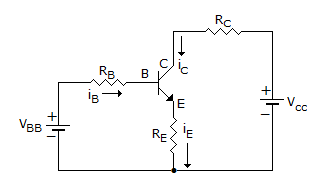Electronics and Communication Engineering - Analog Electronics - Discussion
Discussion Forum : Analog Electronics - Section 1 (Q.No. 20)
20.
The transistor of following figure in Si diode with a base current of 40 μA and ICBO = 0, if VBB = 6V, RE = 2 kΩ and β = 90, IBQ = 20 μA then RB =


Answer: Option
Explanation:
 .
.
Discussion:
13 comments Page 1 of 2.
C.THAMILARASI said:
3 years ago
Ohm law cannot be applied. We have to apply Kirchhoff's voltage law then;
RB = VBB - VBE - IERE/IB = 85 Kohm.
RB = VBB - VBE - IERE/IB = 85 Kohm.
Arthi said:
5 years ago
@All.
We need only resistance at RB.
So there is no need of considering resistance across emitter.
Its just Ohm's law.
R = V/I.
We need only resistance at RB.
So there is no need of considering resistance across emitter.
Its just Ohm's law.
R = V/I.
Artigo said:
7 years ago
ICBO = 0 implying IC = 0 => IE.
So emitter voltage was not considered.
Hence, the equation has only VBB - VRBQ - VBEQ = 0.
So emitter voltage was not considered.
Hence, the equation has only VBB - VRBQ - VBEQ = 0.
Vijay said:
8 years ago
Hi, I'm getting an answer between 100 and 150 whatever the answer is. The given answer is wrong we should consider the emitter resistor.
Please, anyone, explain me.
Please, anyone, explain me.
Pramit said:
8 years ago
The given solution is incorrect. We have to consider the drop across the emitter resistor. And we have to include it in the input loop equation.
Srujana said:
9 years ago
Ibq is base current at operating point taken as 0.7, this 0.7 is the barrier potential voltage at base.
(2)
RONI said:
9 years ago
What is the difference between IB AND IBQ?
Please anyone tell me.
Please anyone tell me.
Bharadwaz said:
9 years ago
Yeah! I have the same doubt. Why shouldn't we consider input loop to find Rb?
I don't think the procedure to find the Rb changes, if the operating point conditions are giving?
If I am wrong, please correct me.
I don't think the procedure to find the Rb changes, if the operating point conditions are giving?
If I am wrong, please correct me.
Raghu said:
9 years ago
What is 40 μA? Why it is given here?
Nitesh said:
9 years ago
I also agree with Arnab.
Can anyone please clarify, if we are wrong somewhere.
Can anyone please clarify, if we are wrong somewhere.
Post your comments here:
Quick links
Quantitative Aptitude
Verbal (English)
Reasoning
Programming
Interview
Placement Papers